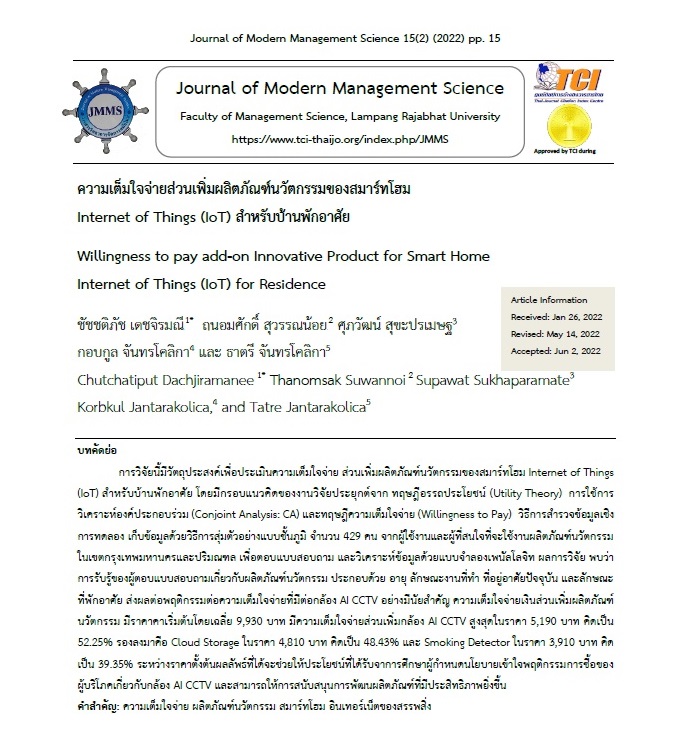Willingness to pay add-on Innovative Product for Smart Home Internet of Things (IoT) for Residence
Main Article Content
Abstract
The purposes of this research were to evaluate the willingness to pay for an innovative product for an as smart home. Internet of Things (IoT) for residents, the conceptual framework was based on utility theory, conjoint analysis: CA, and willingness to pay: WTP. An experimental survey using a stratified random sampling technique was applied to select 429 samples from Bangkok Metropolis and vicinity to answer the self-reported questionnaire. Data ware analyzed by a panel logit model. Research findings revealed that willingness to pay for the respondents' knowledge of innovative products such as age, occupation, accommodation, and the nature of the residence will promote WTP towards behaviors significant. Research findings revealed that willingness to pay for innovative products has an average starting price of 9,930 baht. Willingness to pay for AI CCTV with the highest at 9,930 baht or 52.25% Followed by a Cloud Storage at the price of 4,810 baht or 48.73% and Smoking Detector at 3,910 baht or 39.35%, The obtained results will help policymakers to understand consumer’s purchase behavior of AI CCTV and can provide some effective support for development.
Article Details

This work is licensed under a Creative Commons Attribution-NonCommercial-NoDerivatives 4.0 International License.
The article must be considered and accepted for publication by the editorial board of the Faculty of Management Science, Lampang Rajabhat University. The articles have been reviewed by a peer (peer review) and the author must update according to the suggestion if available before publication. Articles that are not considered the editorial team will inform the results of the consideration but will not send the original to the author.
JMMS is the Faculty of Management Science journal, Lampang Rajabhat University. Jmms published both print and online editions. We allow the use of articles for academic use under the scope of copyright law.
References
Ahmed, B., Abdelouahed, G., & Kazar, O. (2017). Semantic-based approach to context management in ubiquitous environment. Procedia Computer Science, 109, 592–599.
Anderson, J. C., Jain, D., & Chintagunta, P. K. (1993). Understanding customer value in business markets: Methods of customer value assessment. Journal of Business-to-Business Marketing, 1(1), 3-30.
Cha, S. S., & Seo, B. K. (2019). The effect of brand trust of home meal replacement on repurchasing in online shopping. The Journal of Business Economics and Environmental Studies, 9(3), 21-26.
Demirtas E.A., Anagun, A.S, & Koksal, G. (2009). Determination of optimal product styles by ordinal logistic regression versus conjoint analysis for kitchen faucets. International Journal of Industrial Ergonomics, 39(5), 866-875.
Fishburn, P.C. (1968). Utility theory. Management Science, 14(5), 335-378.
Gustafson, A., Ekdahl, F., & Bergman, B. (1999). Conjoint analysis: a useful tool in the design process. Total Qual. Management. 10(3), 327–343.
Han, S. H., Cho, H. Y., & Yang, H. C. (2014). Why do we pay for advertising models: Suggestions for maximizing advertising effectiveness. The Journal of Business Economics and Environmental Studies, 4(1), 15-23.
Hwang, S., & Jung, H. (2018). The interactive effects of motivation and contingent rewards on employee creativity. The Journal of Industrial Distribution & Business, 9(7), 71-82.
Javanmard, H., & Hasani, H. (2017). The impact of market orientation indices, marketing innovation, and competitive advantages on the business performance in distributer enterprises. The Journal of Industrial Distribution & Business, 8(1), 23-31.
John, P. H. (1987). A Satisfactory Benefit Cost Indicator from Contingent Valuation. Journal of Environmental Economics and Management, 14(3). 226-247.
Julia, M. P. (2019). Towards a Utility Theory of Privacy and Information Sharing and the Introduction of Hyper-Hyperbolic Discounting in the Digital Big Data Age. Rais Collective Volume - Economic Science, 10(1), 1-22.
Kaddoura, K., Zayed, T., & Hawari, A. H. (2016). Condition Assessment of Sewer Pipelines using Multi Attribute Utility Theory (MAUT). International No-Dig 2016 34th International Conference and Exhibition, 473, 1-9.
Krichevsky, N., St Louis, R., & Guo,T. (2021). Quantifying and Improving Performance of Distributed Deep Learning with Cloud Storage. 2021 IEEE International Conference on Cloud Engineering (IC2E), 99-109.
Lokesh, K.,Varun kumar. E., Tarun kumar, K., Saikiran. B., Sandeep, K., Narendar, A. & Raveendranadh singh, B. (2021). Home Automation System Based on AI. Journal of Resource Management and Technology, 12(2), 339-344.
Mitchell, R. C. & Carson R. T. (1989). Using surveys to value public goods: the contingent valuation method. Washington, D.C.: Resources for the Future.
Nguyen TT., Haider W., Solgaard HS., Ravn-Jonsen L. & Roth E. (2015). “Consumer willingness to pay for quality attributes of fresh seafood: a labeled latent class model”. Food Quality and Preference, 41, 225-236.
Van N.T., Lim W, Nguyen H, Choi D, & Lee, C. (2010). Context ontology implementation for smart home. arXiv, abs/1007.1273.
Vecchiato, D., Torquati, B., Venanzi, S. & Tempesta, T. (2021). The Role of Sensory Perception in Consumer Demand for Tinned Meat: A Contingent Valuation Study. Foods, 10(9), 1-16.
Višak, T., Baleta, J., Virag, Z.,Vujanović, M., Wang., J & Fengsheng Q. (2021). Multi Objective Optimization of Aspirating Smoke Detector Sampling Pipeline. Optimization and Engineering, 22, 121–140.
Wahyuni, S. (2019). The influence of product innovation, brand image, and physical evidence to purchase decision and WOM of Starbucks in Jakarta. Middle East Journal of Management, 6(2), 123-138.
Wakamatsu, H., Miyata, T. and Kamiyama, R. (2021). Consumer Preference for Cultchless Unspawned Oysters in Japan Using a Contingent Valuation Method and Analytic Hierarchy Process. Journal of International Fisheries, 20, 19-35
Zhang S, McCullagh P, Nugent C, Zheng H, & Black N. (2013). An ontological framework for activity monitoring and reminder reasoning in an assisted environment. Journal of Ambient Intelligence and Humanized Computing, 4(2), 157–168
Zhu, L., Song, Q., Sheng, N. & Zhou, X. (2019). Exploring the determinants of consumers’ WTB and WTP for electric motorcycles using CVM method in Macau. Energy Policy, 127, April 2019, 64-72.


